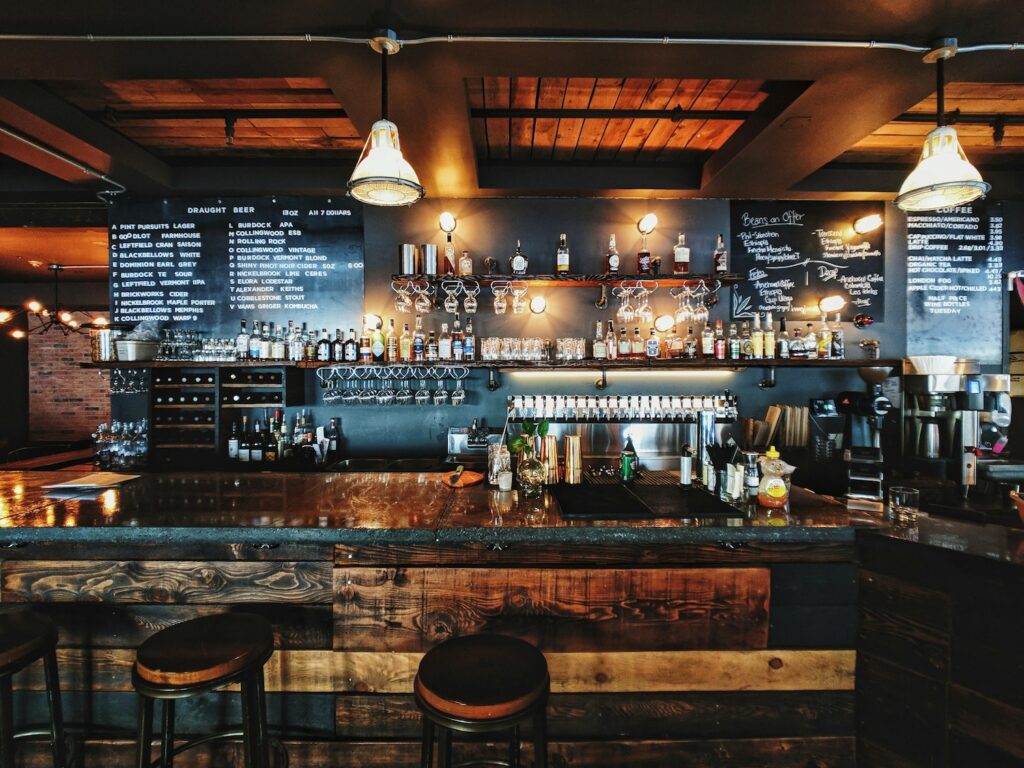
Your restaurant’s website is often the first interaction potential diners have with your brand. A well-designed website can entice visitors, spark appetites, and ultimately drive more customers through your doors. Follow these 7 restaurant website design tips to create an online presence as captivating as your cuisines.
Create an Immersive Atmosphere
Great restaurant web design transports guests to another world; your website should do just that. Use large, high-resolution photos and videos to give visitors a virtual taste of your ambiance and cuisine. To create the best restaurant website user experience, incorporate design elements like patterns, textures, and brand colors that reinforce the vibe you want to create with diners.
For example, as a cozy neighborhood bistro, you might consider creating a website for your restaurant with warm lighting, wood textures, and pops of olive green throughout their website design. Upscale establishments can leverage sleek lines, white space, and black-and-white photography to convey sophistication. Let your unique concept guide guests with visuals, typography, and styling.
Optimise for Mobile-First Browsing
With Google favoring mobile-friendly websites and most visitors browsing on smartphones, responsive design is non-negotiable. Your site must adapt seamlessly to any screen size, from full desktop displays down to small mobiles.
But mobile optimization goes beyond just resizing elements. Design for thumb-friendly and user-friendly navigation with adequate spacing between touch targets. Use high-contrast styles that are easily visible in bright sunlight. And reduce steps wherever possible by anticipating what mobile users want most: current specials, one-click reservations, and easy online ordering, all should be available on the home page.
Design a Craveable Menu
Your menu is your main attraction! This section deserves special attention with design choices that make visitors’ mouths water. Use professional photography to showcase your signature dishes, plated to be picture-perfect.
Organize items strategically with descriptive headers, columns, and sections that allow for effortless scanning. Design enough whitespace around menu items so the layout feels uncluttered. And, consider interactive features like a sticky sidebar menu for faster navigation or promotional callouts that highlight current specials and promotions.
Master the Art of Storytelling
People don’t just dine out for the food; it’s an experience. The design elements of your website should bring your restaurant’s story to life and give visitors a sneak peek of the memorable experience that awaits them. Don’t forget to stay sociable and use all of the available social media channels to push your story and establish your brand.
Maybe it’s a vintage-inspired design aesthetic that celebrates your establishment’s centuries-old building and rich history. Or a playful, artsy vibe with hand-drawn illustrations hinting at your funky, eclectic concept. Create a website design to set expectations and spark diners’ imaginations before they even step foot inside.
Prioritise Tantalising Visuals
The fold — the point where site visitors need to scroll to see more content — is prime real estate. Resist the urge to cram this valuable space with walls of text about your restaurant’s history or mission.
Instead, captivate with intriguing visuals and high-quality images. Use a rotating gallery of vibrant, high-quality photos or videos showcasing your restaurant’s interior, chef at work, positive reviews, or signature dishes. Pair these focal point images with simple overlays like your logo, tagline, and strategically placed call-to-action buttons for booking, ordering, or joining the rewards program.
Guide with Simple Navigation
No one wants to hunt for basic information like your hours, location, or online ordering link. Use clear navigation and strategic placement of crucial elements to create an intuitive browsing experience.
A sticky-top navigation bar is perfect for quick access to high-priority pages like the reviews of your restaurant and menu, reservations, quick access menus, and online ordering. This can also be helped along with breadcrumbs on each page. A prominent click-to-call button, an hours widget, and embedded Google Maps integration on every page prevent frustration when visitors need to find store details.
Don’t Forget the Special Sauce
What sets your restaurant apart? It could be design elements that reflect your locale, like a Tennessee wood-smoked barbecue joint with vintage Southern accents. Or nods to cultural influences like sushi houses with traditional Japanese patterns and minimalism woven throughout.
Look for opportunities to integrate your brand’s unique personality in ways that wouldn’t work for mass-market websites. Delight visitors with thoughtful surprises like animations that mimic your chef’s knife work or an option to switch to your grandma’s recipes written in her script.
With the right blend of appetizing visuals, intuitive UX, and thoughtful touches that capture your concept, you can craft a killer digital presence. An immersive, design-focused website will have hungry visitors booking tables and joining the online ordering queue in no time.
Tips for Ensuring Optimal Website Functionality
If you want your restaurant’s website to be more than just an online brochure and serve as a powerful automation tool, consider adding these key features.
Online Ordering System
Streamline the ordering process by allowing customers to register for an account, browse your menu, add items to a cart, process online orders, and pay seamlessly through an integrated payment gateway. Keep diners updated on their order status for a smooth experience through email addresses and other messaging channels. Only choose the latest ordering solutions, such as 3S POS online ordering system, to ensure that you have all of the innovative features for your customers.
Table Reservations
Give customers the convenience of viewing your floor plan and selecting their preferred seating area or table directly from your website. An online reservations tool eliminates phone tag and manual booking hassles.
Event Booking Forms
For restaurants offering catered events, banquets, or private dining, include online forms where customers can provide details about their event needs and preferences. This centralizes the booking process. Jotform, with all its user-friendly solutions (Smart PDF Forms, Form Builder, and JotForm Approvals), can help you a lot here.
Customer Feedback
Encourage diners to share their experiences by providing an online feedback form or integrating third-party review widgets. Allow photo upload, and be sure to monitor this section closely for spam. Responding professionally builds trust.
Virtual Tour
Immerse potential guests in your ambiance before their first visit with an interactive 360° virtual tour of your dining areas and facilities. This visual preview can help “sell” your atmosphere.
While adding powerful functionality, there are some things you should avoid while you build your restaurant website.
Ending Thoughts
With the right web design decisions, integrating the right tools, and avoiding potential missteps, you can ensure your restaurant website is highly functional. A great website design will facilitate an engaging user experience that complements your brick-and-mortar operations.
Featured image by Patrick Tomasso on Unsplash
The post Tips for Designing a Winning Restaurant Website appeared first on noupe.
